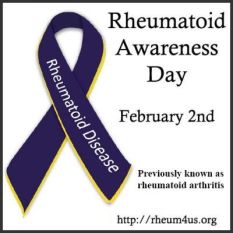February 2nd is Rheumatoid Disease Awareness Day. The RPF: Rheumatoid Patient Foundation, supports this day of awareness for patients, the public, and healthcare providers. This organization was founded by patients for patients.
 You can read about the foundation at this link: http://rheum4us.org/about/ and also check out their educational materials. This site provides a lot of good, sound information for the newly diagnosed and shares progress being made in treatment for those who have been living with the disease for a while. You may choose to join the Foundation, but it is not necessary to access their educational materials. I would encourage you to bookmark their internet page for your own reference.
You can read about the foundation at this link: http://rheum4us.org/about/ and also check out their educational materials. This site provides a lot of good, sound information for the newly diagnosed and shares progress being made in treatment for those who have been living with the disease for a while. You may choose to join the Foundation, but it is not necessary to access their educational materials. I would encourage you to bookmark their internet page for your own reference.
How do you feel about bringing awareness to Rheumatoid Arthritis? I will confess over time, my thoughts have changed about the matter. I went through my stage of research: having to read everything about the disease to educate myself. Then I went through the woe is me stage as I struggled to cope. I became angry because no one knew what the disease was about and did not believe my level of suffering. The public compared my hellish suffering to osteoarthritis. I thought if one more person compares a disease that has leveled my life to rubble to their pinky “killing” them I might just be fitted for a orange jumpsuit with a life sentence. Funny though, living with rheumatoid disease is a life sentence in it’s own right minus the orange jumpsuit. One is imprisoned by their own body. The jailer is the immune system gone haywire. The disease took me down kicking and screaming. One day … over time … and with God’s help I realized I had to let it go. I felt like I was at the end of my coping. I was growing bitter. It wasn’t serving any purpose to focus on the injustice of it all except to keep me ripe for a flare.
Today I can look at awareness for rheumatoid arthritis as just that: awareness. You may in the lifetime you have this disease bring some people to a level of awareness but no one will ever fully get what your situation is like except for another patient with the same disorder. Even then, you may share the same disease, but your symptomology won’t be exactly the same. You will have a shared understanding of what it means to suffer… as they say “misery loves company”. Still no one knows what it is like for you except for you and your maker. Finally I realized there are two groups of rheumatoid disease patients: those surviving it with hope or those surviving it with despair. I made the choice to survive in hope.
The awareness I would like to leave with you as this day of rheumatoid disease awareness approaches is that you never have to be alone in despair with this disease again. When no one else understands, Christ does. When your doctor can’t help you, Christ can. When you don’t think you can take another step forward, Christ will carry you. He is there waiting for you to accept Him. No medication, physician, spouse, family can ever provide what He gives freely: salvation. It is only through my personal relationship with Christ that I am surviving chronic pain and illness with hope. I know this world is not my home. I have hope for an eternal future in heaven with Christ where there will be no more tears, no more pain, no more suffering. I refuse to live my life defeated. Instead I am victorious in Christ because this disease won’t hold me in a grave. If you don’t know Christ then I ask you to reach out to Him. My healing may not happen in this world, but it will happen in Heaven and that is my awareness as I enter my 7th year of enlightenment. John 3:16.
